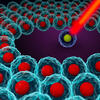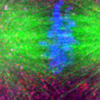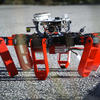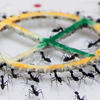You are here
How Honeybees Learn from Floor to Ceiling

Researchers have long known that honeybees use a combination of sunlight and visual cues to forage and make it back to their hives—with a perfect landing. But to navigate, and like many other insects, they rely on something called optical flow: the pattern in which images of the world move in relation to the traveling insect, from the front to the back of its visual field. A better understanding of this faculty has long been of interest for building lighter navigation systems that could be used on tiny drones, relying on optical flow rather than on more energy-hungry and heavy GPS, lidar, or radar technologies.
To find out more on how optical flow-based learning and altitude control interplays, biorobotics specialists from the Institute of Movement Sciences1 devised an experiment that consisted in having bees travel through a tunnel to find a nectar reward. The tunnel had an identical texture on every surfaces including on the floor and ceiling, and the honeybees were first trained to enter it via an opening at either the floor or ceiling level. The researchers observed that the honeybees were able to follow the ceiling. Based on this original finding, the authors wanted to know whether the honeybees would continue to follow the ceiling if the configuration of the tunnel was suddenly changed. So between two consecutive trajectories, they removed a small section of the ceiling, resulting in a sharp increase in the tunnel’s height. Despite this sudden change, the honeybees continued to keep the same distance from the surface they were following—whether it was the floor or the ceiling. “We observed that, depending on how they entered—ceiling or floor—the honeybees were able to change their altitudes to restore the optical flow patterns they had previously memorized,” explains researcher Franck Ruffier, who helped devise the experiment.
Figure 1. Despite the insertion of a dorsal ditch in the tunnel between two consecutive flights, the honeybees continued to keep the same distance from the surface they were following, whether it was the ceiling (A) or the floor (B), using the optic flow cues they perceived.
© Geoffrey Portelli, Julien Serres, Franck Ruffier
In order to determine what cues were used by the honeybees when performing this task, they were made to take the opposite tunnel entrance to the one they had previously learned to use. “If they had trained on the ceiling, they were made to take the floor entrance and vice versa,” adds Ruffier. What the researchers found was that the honeybees followed the ceiling or the floor at a distance that did not differ significantly from that recorded just after the training phase, using the same optic flow pattern they had learned, the image flow of the floor or ceiling that sweep across the honeybees’ visual field.
Figure 2. After being made to take the opposite tunnel entrance to the one they had previously learned to use, the honeybees kept following the ceiling (A) or the floor (B) at a distance which did not differ significantly from that recorded just after the training phase, using the same optic flow pattern. © Geoffrey Portelli, Julien Serres, Franck Ruffier
To control their altitude, the honeybees used both their motion vision processes and their memory. More specifically, they used a large optic flow pattern they perceived in their dorsal or ventral viewfield to follow the ceiling or the floor, respectively: they learned these optic flow patterns during the training phase, memorized them and subsequently restore them by adjusting their altitude in order to follow either the ceiling or the floor.
These findings, which were just published in the journal Scientific Reports,2 are important for the researchers who are using a similar visual strategy on the airborne robots they design, like the BeeRotor, a miniature tethered tandem rotorcraft, which “is capable of controlling its altitude by safely following the floor or the ceiling using the optic flow cues generated by these surfaces and measured in degrees per second by means of tiny artificial retinas,” adds Ruffier. This research is an example of how the innovative field of biorobotics can yield both fundamental and applied results.











